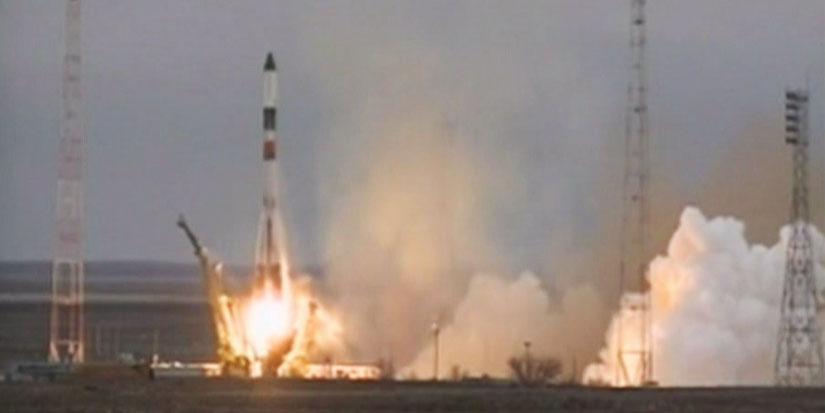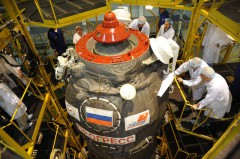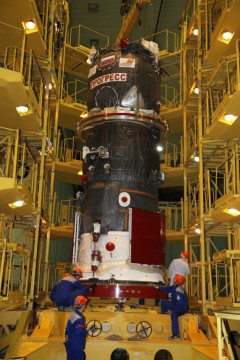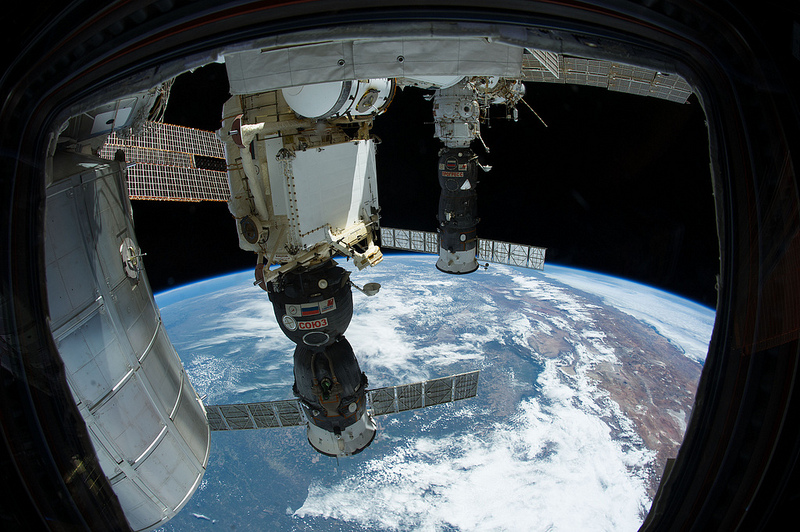
Russia has successfully delivered its first mission of 2015 to the International Space Station (ISS), with the successful liftoff of Progress M-26M—also designated “Progress 58P” in ISS Program nomenclature—from Site 1/5 at the Baikonur Cosmodrome in Kazakhstan. The three-stage Soyuz-U booster roared away from Earth precisely on time at 5:00:17 p.m. local time (6:00:17 a.m. EST) Tuesday, 17 February, bound for a six-hour, four-orbit “fast rendezvous” to reach the space station and resupply the incumbent Expedition 42 crew. Following a picture-perfect flight, Progress M-26M completed a smooth docking with the aft longitudinal port of the Zvezda module—only recently vacated by Europe’s fifth and final Automated Transfer Vehicle (ATV-5)—at 10:57 p.m. Baikonur time (11:57 a.m. EST). The docking came one minute earlier than planned, as Progress and the ISS flew high above the north-east of Puerto Rico. Laden with 5,225 pounds (2,370 kg) of equipment, experiments, spare parts, clothes, food, water, and fuel, this was the 60th ISS-bound Progress to be launched since Progress M1-3, way back in August 2000, and the 149th in the program’s 37-year history.
As outlined in AmericaSpace’s preview article, Progress M-26M is the latest in a long lineage of unpiloted visiting vehicles to Soviet, Russian, and now international space stations. Its earliest variant was launched to the Salyut 6 station in January 1978, in which it delivered supplies to the Soyuz 26 crew of Yuri Romanenko and Georgi Grechko, who were midway through a record-breaking 96-day mission which would soundly eclipse the 84-day achievement of the final Skylab crew. In total, 12 Progresses flew to Salyut 6, the last in January 1981, after which a further 13 journeyed to the Salyut 7 station between May 1982 and July 1985. No less than 64 Progress craft were launched to Mir between March 1986 and January 2001—the last of which, Progress M1-5, provided the necessary impulse to deorbit the aging station on 23 March of that year—and with today’s successful flight of Progress M-26M a total of 60 have been boosted toward the ISS.
Although there have been numerous rendezvous and docking anomalies over the years, including two incidents during the Mir era—a near-miss by Progress M-33 during a failed re-docking attempt in March 1997 and an actual impact by Progress M-34 in June 1997, the latter of which punctured the station’s Spektr module and resulted to its permanent depressurization and disuse—and several failures of the TORU and Kurs (“Course”) rendezvous hardware, Progress has proven a highly reliable mainstay of Salyut, Mir, and ISS operations. On 2 February 2003, the launch of Progress M-47 not only marked the 100th Progress mission, but also came just a few short hours after the tragic loss of Columbia. Over the next 2.5 years, these spacecraft were the sole means of delivering large quantities of cargo and supplies to the station’s incumbent crews. It came as a great surprise in August 2011, when Progress M-12M’s booster suffered a blocked fuel duct and experienced an engine failure during third-stage flight, causing the first-ever Progress Loss of Vehicle. Since August 2012 and the flight of Progress M-16M, most missions have followed a shortened flight profile to reach the ISS, lasting about six hours and four orbits of Earth, rather than the previously standard two-day rendezvous regimes.

In readiness for today’s liftoff of Progress M-26M, the cargo ship was fueled with nitrogen tetroxide and unsymmetrical dimethyl hydrazine (UDMH) propellants and compressed gases during the first week of February, before being transferred to Baikonur’s Spacecraft Assembly and Testing Facility for final closeouts. Last Thursday (12 February), it was encapsulated within its bulbous payload shroud, and on Sunday, amid the gloom of a midwinter fog and with snow on the ground at Baikonur, the Soyuz-U booster was rolled horizontally out to Site 1/5 and elevated to a vertical orientation.
The Soyuz-U booster is a direct descendent of Chief Designer Sergei Korolev’s R-7 Semyorka (“Little Seven”) intercontinental ballistic missile, and upon arrival at the pad electrical and propellant umbilicals were connected as technicians set to work charging batteries and preparing for fueling operations. The process of loading liquid oxygen and a highly refined form of rocket-grade kerosene—known as “RP-1”—aboard the vehicle ahead of Tuesday’s launch attempt began about five hours before T-0, after which the Soyuz-U transitioned to a “Topping Mode,” whereby all boiled-off cryogens were rapidly replenished until close to liftoff. This ensured that the liquid oxygen tanks were maintained at Flight Ready levels, ahead of the ignition of the Soyuz-U’s single RD-118 engine and the RD-117 engines of its four tapering strap-on boosters.
At 4:15 p.m. local time (5:15 a.m. EST), the service tower was retracted from the vehicle, exposing the Soyuz-U and the conspicuous green “cap” at the apex of the payload shroud. With no issues being worked of a technical nature, and Baikonur largely devoid of snow on Launch Day, the booster’s propellant tanks were pressurized for flight. Internal avionics were initiated and the on-board flight recorders were spooled-up to monitor the rocket’s myriad systems throughout ascent. At T-5 minutes, the “launch key”—an actual, physical key to command the ordnance—was inserted, followed by gaseous nitrogen purging shortly thereafter. At this point, it was anticipated that the ISS itself would be flying about 257 miles (413 km) above southern Russia, near the Mongolian border, and would be about 1,370 miles (2,200 km) “ahead” of Progress M-26M at the point of orbital insertion.

With one minute remaining before liftoff, the Soyuz-U transitioned to internal power and the first umbilical, then the second, were retracted. At T-10 seconds, the turbopumps on the core and strap-on boosters came to life, and, following confirmation that all engines were burning at full power, the fueling tower was retracted and Progress M-26M roared into the cold Baikonur sky, bound for the ISS.
Rising rapidly, the vehicle passed 1,100 mph (1,770 km/h) within a minute of leaving Site 1/5, during which period the maximum amount of aerodynamic stress—colloquially known as “Max Q”—impacted its airframe. At T+118 seconds, having attained an altitude of 28 miles (45 km), the four strap-on boosters exhausted their supply of liquid oxygen and RP-1 and were jettisoned, leaving the core stage and its single engine to continue the ascent. By two minutes into the flight, the Soyuz-U was traveling in excess of 3,350 mph (5,390 km/h), with the vehicle’s performance described by NASA’s Rob Navias as “very stable.”
The payload shroud and escape tower were discarded, and, four minutes and 50 seconds after leaving Baikonur, the core stage separated at an altitude of 105 miles (170 km) and the RD-0110 engine of the third stage ignited at T+4 minutes and 57 seconds to boost Progress M-26M to a velocity of over 13,420 mph (21,600 km/h). By the time the third stage was jettisoned, at T+8 minutes and 45 seconds, the vehicle was in space, and Progress M-26M separated into free flight shortly afterwards.
Separation of Progress M-26M from the third stage of the Soyuz-U took place into a target orbit of about 120 x 152 miles (193 x 245 km), inclined 51.6 degrees to the equator. Shortly thereafter, the process of unfurling the cargo ship’s twin solar arrays and Kurs (“Course”) rendezvous and navigational appendances commenced. Two maneuvering “burns” were performed during the first orbit of Earth, the first at 5:43:11 p.m. Baikonur time (6:43:11 a.m. EST) and the second at 6:09:41 p.m. Baikonur time (7:09:41 a.m. EST), which gradually increased the altitude of the spacecraft from 133 x 157 miles (215 x 253 km) to 150 x 164 miles (242 x 264 km). This was followed by another pair of maneuvering burns during the second orbit, expanding the altitude yet further from 162 x 170 miles (260 x 275 km) to 167 x 185 miles (269 x 297 km). By the time these four burns were concluded, the proper conditions had been created for Progress M-26M to follow an automated rendezvous and docking regime to reach the ISS. The regime was completed ahead of the timeline and by 10:50 p.m. Baikonur time (11:50 a.m. EST), the cargo craft was at a position just 165 feet (50 meters) from the space station.

Watched intently from aboard the ISS by cosmonauts Aleksandr Samokutyayev and Anton Shkaplerov, docking at the aft longitudinal port of the Zvezda service module took place at 10:57 p.m. Baikonur time (11:57 a.m. EST), some five hours and 57 minutes after launch, and a minute ahead of schedule, where Progress M-26M will remain until the end of August. At the point of capture, the two spacecraft had recently passed high above the north-east of Puerto Rico. As described by the Russian Space Agency, the spacecraft is carrying 5,225 pounds (2,370 kg) of equipment, experiments, spare parts, clothes, food, water, and fuel to the space station’s Expedition 42 crew, which consists of Commander Barry “Butch” Wilmore of NASA, Russian cosmonauts Aleksandr Samokutyayev, Yelena Serova, and Anton Shkaplerov, U.S. astronaut Terry Virts, and Italy’s first woman in space, Samantha Cristoforetti.
As well as propellant, compressed gases, and about 925 pounds (420 kg) of water, the Progress carries 3,230 pounds (1,465 kg) of cargo in its pressurized compartment. This includes gas filters, sensors and analyzers, sanitary and medical equipment, food containers, smoke detectors, hardware for the thermal control system, a new hard drive, cables and laptop computer, crew support equipment—including Omega watches and care packages—and about 310 pounds (140 kg) of clothing, stationery, and hygiene items for the U.S. Orbital Segment (USOS) crew. Additionally, Progress M-26M carries Russian experiments in support of geophysical, biomedical, biological, biotechnological, and technical experiments, as well as tools for maintenance and repair.
Want to keep up-to-date with all things space? Be sure to “Like” AmericaSpace on Facebook and follow us on Twitter: @AmericaSpace
Missions » Progress »



2 Comments
2 Pings & Trackbacks
Pingback:Russians send 60th Progress cargo ship to ISS | Off to the Space Races
Pingback:All-Civilian Soyuz TMA-17M Crew Ready for Wednesday Launch to Space Station (Part 1) « AmericaSpace